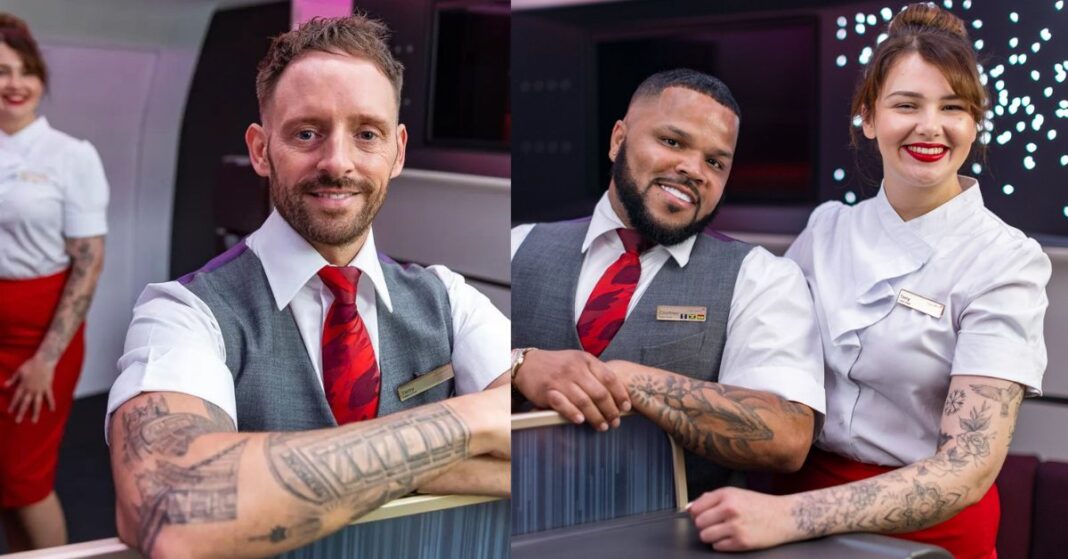For jobs like being a flight attendant, how you look is really important in making passengers feel a certain way. This includes things like the clothes you wear, how you do your hair, and even any tattoos you have.
As people’s opinions change, tattoos have gone from being seen as not okay to being seen as cool ways for people to express themselves.
This blog is all about explaining the rules for how flight attendants should look, talking about how people now feel about tattoos, and looking at how these two things come together for flight attendants.
Table of Contents
Can flight attendants have tattoos and piercings?
The Inkwell Conundrum:
One of the first challenges facing flight attendants with a penchant for body art is the visibility of tattoos. Many airlines draw a firm line against visible ink on the face, neck, hands, and arms, deeming them incompatible with the desired professional image.
However, some carriers allow a more lenient approach, permitting discreet tattoos on areas like wrists or ankles, provided they are covered by the uniform.
For those with a canvas of hidden ink, the landscape becomes more accepting. Discreet tattoos on less visible body parts are often tolerated as long as they remain concealed under the uniform, even during the dynamic movements inherent in the role.
However, there’s often a catch – airlines may explicitly forbid the use of bandages or makeup to cover tattoos, preferring an unembellished appearance.
Piercing Patrol:
While tattoos present a visible challenge, piercings come with their own set of rules. Facial piercings, particularly nose rings or eyebrow studs, are often frowned upon due to their perceived informality.
In contrast, earlobe piercings are generally more acceptable, with specific limitations on the number or type of stud or ring allowed.
Beyond Policies: The Human Element:
Beyond the black-and-white of official policies, there’s a human element at play. The culture within an airline, individual managerial discretion, and the demographics of passengers can all influence how strictly these policies are enforced.
While some flight attendants might discreetly flaunt their tattoos or piercings without raising eyebrows, others may find themselves under a stricter microscope.
The Future of Flight Aesthetics:
As societal norms around body art evolve, so too does the conversation within the aviation industry. Recognizing the value of diversity, some airlines are starting to relax their policies. The idea is to embrace the unique talents and perspectives that tattoos and piercings can represent, acknowledging that professionalism and personal expression can coexist.
Additional Considerations:
- The content of tattoos and piercings matters. Airlines are likely to prohibit offensive or discriminatory imagery regardless of the location.
- Some airlines differentiate policies for new hires and existing flight attendants, adding an extra layer of complexity.
- Temporary tattoos, henna, and similar body art might be subject to separate guidelines.
What airlines allow tattoos for flight attendants?
In some airlines, it’s okay for flight attendants to show off their tattoos! Virgin Atlantic and Alaska Airlines are cool with it, thinking it’s more important to look stylish and professional than to have strict rules. But not every airline is the same. American Airlines and Delta usually want tattoos hidden under the uniform.
United is a bit more flexible, letting flight attendants have small tattoos like a credit card size, but there are some rules to follow. The skies are changing, but different airlines still have different ideas about tattoos.
Do Emirates allow tattoos?
Regrettably, Emirates has a pretty strict rule about tattoos for its cabin crew. Unlike some other airlines that are easing up, Emirates doesn’t allow any tattoos that can be seen when the crew members are in uniform. This rule applies to both men and women and covers tattoos on arms, legs, and any other areas that might show under the uniform.
Does Qatar Airways accept cabin crew with tattoo?
Starting from September 2023, if you’re applying to work for Qatar Airways and you have tattoos that can be completely hidden by the uniform, they might think about it. You’ll have to tell them about your tattoo when you apply and share a photo of it. They’ll decide on a case-by-case basis, considering things like how big the tattoo is, where it is, and what it looks like.
Why tattoos are not allowed in cabin crew?
Whether cabin crew members can have tattoos depends on the rules of the airline, the culture they operate in, and the nature of the tattoo. A lot of airlines don’t allow visible tattoos because they worry about their image, what passengers expect, and their global reputation.
But things are changing, and some airlines are more accepting, understanding that tattoos don’t affect how professional someone is. If you want to be cabin crew with tattoos, make sure to check the policies of the specific airline you’re interested in to see if they’re okay with it.
Can United Airlines flight attendant have tattoos?
From August 2021, United Airlines has become more open-minded about tattoos. It’s not as strict as before. Now, you can have tattoos, but they shouldn’t be on your face, neck, or hands. Also, they should be smaller than a credit card, like something nice, not too big or fancy.
Just be careful, offensive or mean pictures are not allowed. And try to stick to one tattoo on each arm or leg that people can see. If your tattoo shows under the regular uniform, that might be a problem.
Do airlines allow sleeve tattoos?
Most airlines don’t say no to hiring because of tattoos, but where they are matters. If your tattoos can be seen, it’s usually okay if they’re small, in a good spot, and not rude. Every airline has its own rules, so look on their websites or talk to people who work there.
When you interview, be honest about your tattoos. Keep in mind, that some airlines might want you to hide them when you’re training or working.
How do flight attendants hide tattoos?
People often use long sleeves or special sleeves for their arms, and scarves or clever jewelry can help with neck tattoos. If you have small tattoos, makeup that matches your skin color can help hide them, and wearing tights that match your skin tone can cover leg tattoos. Just remember, what’s most important is feeling comfortable and following the rules of the airline.
Also Read: How to become a Flight Attendant?
Tattoos as an Expression of Individuality
Building on these solid foundations, let’s explore the trendy topic on everyone’s lips – tattoos. Undoubtedly, tattoos are an everyday reality in our lives. They are no longer the symbols of rebellion they once were, as more of our favorite celebrities, athletes, and influencers proudly sport them.
In these times, where originality and uniqueness are celebrated, tattoos have morphed into a prevalent medium of personal expression and identity.
And yet, we have to ask: Do tattoos have a place in the aviation sphere? More precisely, should tattoos be permitted as an acceptable form of personal expression among flight attendants?
To answer this question, we’ll have to examine how the aviation industry and societal perceptions are evolving. Simultaneously, we’ll need to weigh the importance of retaining traditional professional boundaries.
We live in an era where popular brands are remodeling their image to capture the essence of authenticity. Businesses, including airlines, are seeking ways to humanize their brands by embracing the individuality and preferences of their employees.
Doing this, they believe, will help create deeper connections with their customers. As such, tattoos could allow flight attendants to let that individuality shine and resonate with passengers.
Tattoos clash neither with an airline’s commitment to safety nor its dependability. Murphy’s law applies everywhere, and having ink on your arms doesn’t deter you from expertly dealing with emergencies. The aptitude of a flight attendant is not reflected by tattoos but by their skill and commitment to ensuring passengers’ safety and comfort levels.
Yet, we can’t skim over the reality that many passengers still maintain traditional views on tattoos. For these travelers, a flight attendant’s tattoos may negatively impact their perception of the airline’s discipline, professionalism, and overall image.
So how do we strike a balance? How do we honor the employee’s freedom of self-expression and the client’s comfort?
Perhaps airlines can adopt a middle ground – allow modest, tasteful tattoos that aren’t offensive, inappropriate, or excessive. In essence, tattoos that hark back to the personality of the flight attendant don’t deter from the overall professionalism and image of the airline.
After all, aviation aesthetics are not rigid constructs but evolving perceptions tailored around customer service, unique in-cabin experiences, and comfort delivery.
The question of tattoos on flight attendants is an open dialogue, one interwoven with notions of acceptance, modernity, aesthetics, and traditional professionalism.





